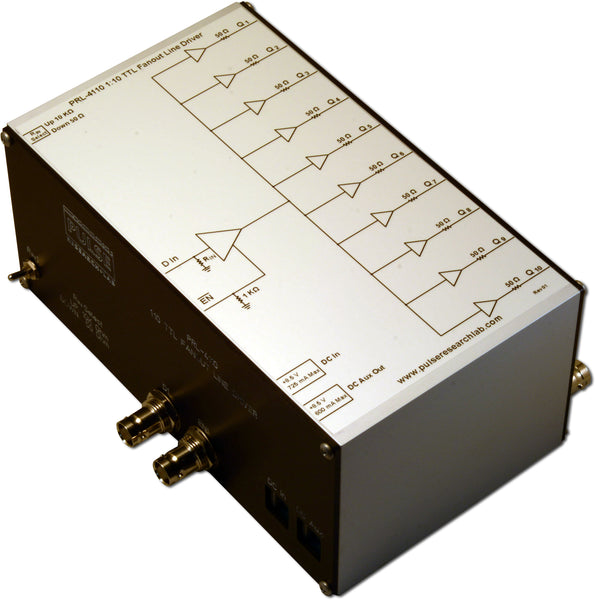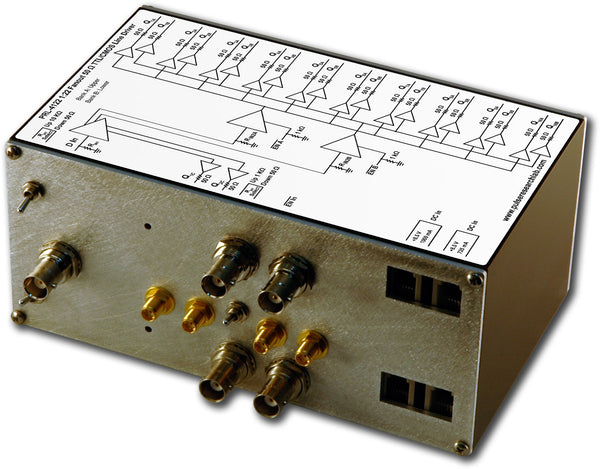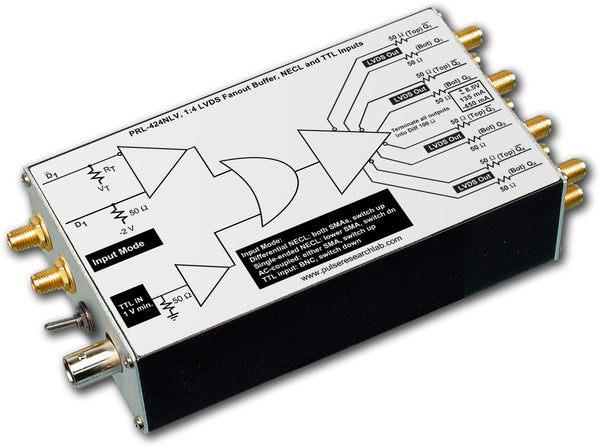Applications:
|
|
Features:
|
|
DescriptionThe PRL-414TRSBTR is a 1:4 fanout or 2 x 1:2 fanout RS-422 line driver with two 50 Ω BNC TTL inputs and four 124 Ω differential RS-422 outputs. The PRL-414RSTR high speed fanout line driver facilitates testing and integration of high speed digital communications circuits and distribution of satellite signals. The PRL-414TRSBTR has two fanout modes, selectable by a toggle switch:
The four sets of complementary outputs are 62 Ω back-terminated and designed for driving floating 124 Ω loads, normally the configuration used in RS-422 input circuits. The output swing is typically 1.40 V with a common mode voltage of 1.55 V. . Because every output is independently buffered, unused outputs do not require termination, and outputs can even be shorted without affecting other outputs. These applications would not be possible with a passive splitter or powered distribution amplifier. Multiple units of PRL-414TRSBTR can be cascaded for wider fanout, such as 1:16 or higher. The PRL-414TRSBTR can be combined with other PRL products and integrated into a rack-mount system using PRL's modular rackmount kit, PRL-MRK3-1. All I/Os are Triax, using Trompeter CBBJR79 or equivalent, and will mate with any Trompeter 70-series Triax Cable Plug with 3 lugs, or compatible connector. The PRL-414TRSBTR is supplied with a ±8.5 V/1.4 A AC/DC adapter and housed in a 1.3 x 2.9 x 6.0-in. extruded aluminum enclosure. Available accessories include voltage distribution modules and shielded twisted pair cables with Triax termination:
A related model is available with RS-422/Triax inputs, the PRL-414RSTR. |

(0° C ≤ TA ≤ 35° C)*
| Symbol | Parameter | Min | Typ | Max | Unit | Comments |
|---|---|---|---|---|---|---|
| RIN | Input Resistance | 50.0 | Ω | |||
| ROUT | Differential Output Resistance | 124 | Ω | |||
| VIL | Input Low Voltage | 0.0 | 0.8 | V | ||
| VIH | Input High Voltage | 2.0 | 5.0 | |||
| VOL | Output Low Level | 0.85 | V | |||
| VOH | Output High Level | 2.25 | V | |||
| VOPP | Voltage Output, peak-to-peak | 1.4 | V | |||
| VCMO | Output Common Mode Voltage1 | 1.55 | V | |||
| IDC1 | DC Input Current | 300 | mA | F = 25 MHz | ||
| IDC2 | DC Input Current | 400 | mA | F = 50 MHz | ||
| IDC3 | DC Input Current | 500 | 550 | mA | F = 75 MHz | |
| VDC | DC Input Voltage | +7.5 | +8.5 | +12.0 | V | |
| VAC1 | AC/DC Adapter Input Voltage, 120 V | 103 | 115 | 127 | V | |
| VAC2 | AC/DC Adapter Input Voltage, 220 V | 206 | 220 | 254 | V | |
| tPLH | Propagation Delay to output ↑ | 20 | ns | |||
| tPHL | Propagation Delay to output ↓ | 20 | ns | |||
| tr/tf | Rise/Fall Times (10%-90%)2 | 2.8 | 3.5 | ns | ||
| tSKEW1 | Differential Skew between Q and Q ̅ | 200 | 350 | ps | ||
| tSKEW2 | Skew between any 2 outputs | 1000 | 1500 | ps | ||
| fmax | Max Clock Frequency3 | 75 | 80 | MHz | ||
| Size | 1.3 x 2.9 x 6.0 | in. | ||||
| Weight | 9 | Oz | w/o AC adapter | |||
| Shipping Weight | 4 | lb | w/AC adapter | |||




